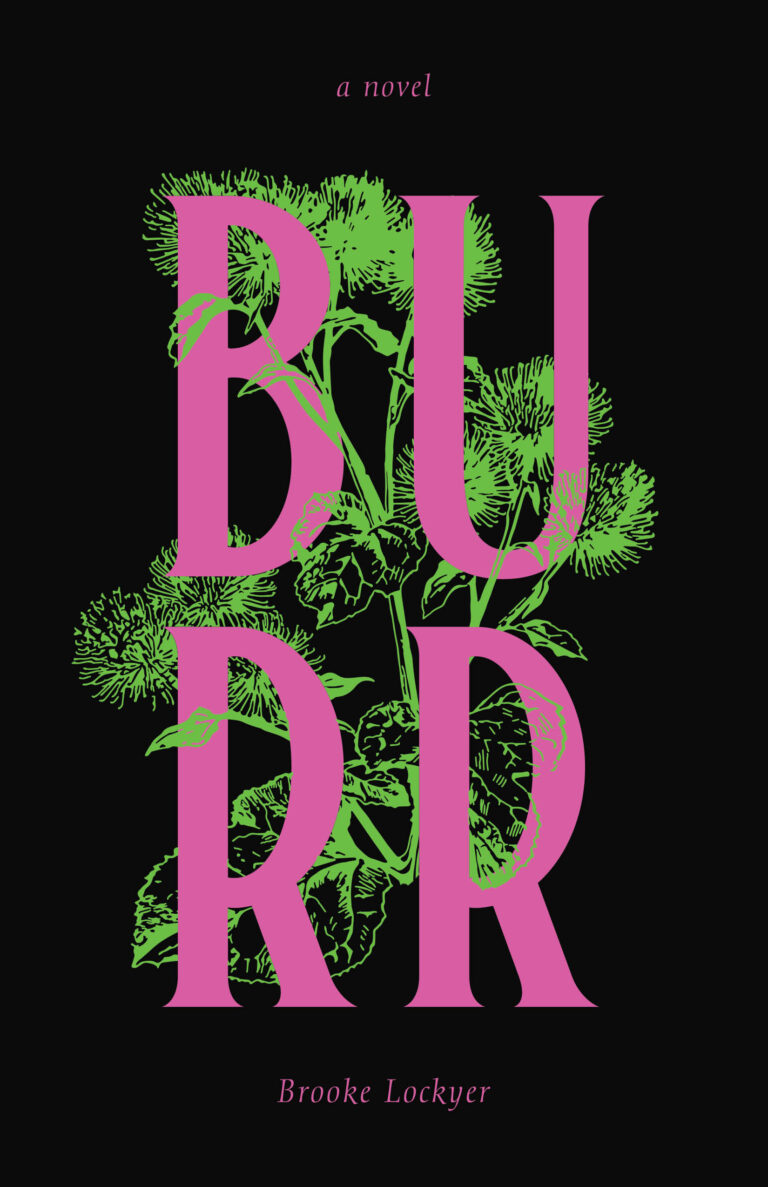Review of Burr
Nightwood Editions. 2023. 287 pages.
When someone you love dies, the world shifts. It’s as if a parallel life beckons; you find yourself drawn to an alternate landscape which can feel like a waking dream. In Burr, the debut novel by award-winning Canadian writer Brooke Lockyer, Jane Blackburn faces the loss of her father. Death hovers over Burr, becoming its fulcrum and its laser focus, but more than simply exploring the empty space, the novel asks us to ponder how we live with that space and what we do to fill it, to keep it from devouring us. Creating a tapestry of imagery and emotions, Lockyer’s novel captures crucially and profoundly how normal restraints loosen when your heart breaks.
The novel’s inciting incident is Jane’s father’s death at the age of 39 while jogging with his wife, Meredith, on the couple’s anniversary. The death is impossible for young Jane to accept; when we meet her, she is searching the house for signs of life –touching, tracing, sniffing, even drawing blood when she drags his razor over her thumb. She’s 13, that age when senses are heightened and nerve endings tingle with a newfound awareness of one’s body and its longings, and no methods to cope. Jane’s grief is visceral, felt on her skin and in her bones. Pairing sensitive and imaginative writing Burr is a novel with a unique physical and emotional presence.
The novel deals with the cosmic nature of grief, the sense of it being vast and unending, while being firmly planted on the earth. The book’s multiple perspectives allow Jane and the other characters to tell their stories in alternating short sections. It’s a format that could have interrupted the flow of the action, but it works here. Grief is personal and everyone’s shifting landscape is different. Lockyer isn’t afraid to push the limits with sensuous language, and the intimacy she achieves with each character’s perspective is compelling.
Meredith walks to cope, her nightly insomniac perambulations taking her out of Burr–the small Southwestern Ontario town in which the novel is set and where she and Henry happily settled after marriage–into the wild of the surrounding forest. At one point she discovers a bedroom in the woods which seems part wish fulfillment, part hallucination. Meredith feels Henry all around her, smells him. She brings a photo from the house, her slippers, his sweaters, and suits that she hangs from the trees. This forest bed seems fantastical, but when grief haunts your days, it can feel like anything is possible. You’re sliced open, available to receive whatever solace the universe offers – and ready to conjure it yourself through magical thinking.
Jane feels her mother’s absence, the gradual deletion of a woman who liked to have fun and knew about “witch trials and Mongolian eagle hunters.” As Jane puts it, her mother was like a “star, twinkling remotely from outer space.” As Jane and Meredith drift, the novel captures how young people deal with grief by transgressing rules. Jane plays hooky from school, pulls away from her friend Annie. She rides her bike along the routes she and her father cycled together, along the same route her parents took the day Henry died. Jane wishes she could dig herself into the ground to be with her father, with the bugs and dirt. When it rains, her mother Meredith imagines Henry’s body washing up like a jellyfish on a beach.
The music that plays in the background in so many scenes adds to the sensory richness. Ernest whistles “Thinking Blues,” sung by Bessie Smith, when he and Jane ride the Ferris wheel at the Western Fair. Meredith notices the howling of the 1990s iconic band, Siouxsie and the Banshees, coming from Jane’s room. Johnny Cash singing “Ring of Fire” reminds Jane of the music her dad played in the car.
The subplot of Burr concerns Ernest, the elderly town misfit. For years, he has lived in his own world of grief, haunted by the drowning of his nine-year-old sister, Evelyn. No one in town understands Jane’s sorrow like Ernest and the two outsiders are drawn to each other through grief. Lockyer depicts this unlikely friendship hauntingly, and the journey they take together is masterfully developed with quirky secondary characters. Part two of this three-part novel is their story, which is fast-paced and hard to put down. Ernest isn’t a character who is initially easy to relate to. He has experienced loss, institutionalization and lives as a recluse. But beneath the surface, he is a brave survivor waiting to be recognized. When Jane asks Ernest what happened to his sister, “there’s relief in his face, as if he’s been waiting a long time for someone to ask.”
Ernest, Jane and Meredith are genuine characters. Like the family and friends in our own lives, they are not perfect. Broken and grieving, they do odd things and push people away, but Lockyer writes without judgment, allowing them the space and time they need. Her humanity and compassion convinced me and kept me reading.
I wanted to turn away sometimes from the intensity of the imagery and emotions in Burr, but that is the nature of grief: it’s relentless. Lockyer captures this fierceness with writing that is vivid and powerful. So many sentences pierce your defenses, yet the story never loses its flow. The river of grief that runs through the book eventually carries us to an ending which is fluid and thought-provoking. You begin this book feeling sorrow and disorientation and you end it feeling reassured that there is a way back after loss. In the final section, in a series of evocative snapshots, the characters resume life in Burr. We can see that they have been changed by their grief, that they have unanswered questions but there’s no going back or standing still, there’s only going through.

